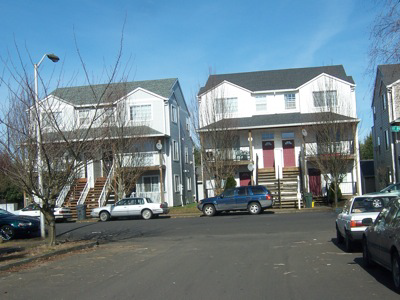No Light Rail in Vancouver!
Light rail costs too much, does too little
Urban Planning “Saves” Another Neighborhood
At one time, Argay Terrace was a boring suburban neighborhood, housing middle-class
families whose lives were so dull they didn’t even know they were missing the excitement
of lively streets. Now, thanks to Portland’s urban planners, Argay has become a vibrant,
mixed-use neighborhood that offers retail and service business so residents don’t
have to drive to get everything they need.
“When I was in school,” says a local resident, “we used to call Argay Terrace ’snob
hill’ because that’s where all the rich kids lived.”
Photo by ORTEM.
Unfortunately, the retail and service businesses are drugs and prostitution, which
have grown by almost 300 percent in the last four years alone. The streets today
are so vibrant that longtime residents are afraid to walk around at night without
a concealed weapon, and many strangely prefer a little less vibration and have moved
out.
How did urban planners accomplish this amazing neighborhood turnaround? First, they
drew an urban-growth boundary around the region, driving up land prices and limiting
suburban development. Second, they rezoned Argay and other neighborhoods along Portland’s
light-rail line for “infill” development of apartments and other high-density buildings,
and gave developers tax breaks and other subsidies to build such complexes.
Land-use attorneys invented zoning in the early part of the 20th century to protect
neighborhoods of single-family homes from being invaded by high-density housing;
in the 21st century, Portland planners use zoning to impose “infill” developments
on neighborhoods like Argay Terrace.
Photo by ORTEM.
Some yuppies without children were attracted to high-density developments, like the
Pearl, in and near downtown Portland. But few wanted to live in a shoddily built
apartment many miles from downtown.
Meanwhile, many yuppies with children found they could not afford to buy new homes
with yards. So they gentrified inner Northeast Portland, long a low-income neighborhood
with high percentages of renters. The renters were forced out and many went to, guess
where, the shoddily built suburban apartments along the light rail.
Robert Liberty, current member of the Metro council and former director of 1000 Friends
of Oregon who originally promoted densification, argues that density alone does not
increase crime. He is probably right: pack a thousand multi-millionaires into a high-density
downtown condo and you aren’t going to get much more crime than if they were living
on one-acre suburban tracts.
But density makes it harder to design neighborhoods that are less vulnerable to crime.
One of the best deterrents to crime, private yards, are difficult to provide when
you insist on 24-unit-per-acre apartments.
I imagine that ripping low-income families away from the neighborhoods where they
have ready access to support services and scattering them all over an urban area
doesn’t do much to reduce crime rates either. Part of the problem is that the low-income
families displaced from inner Northeast Portland are minorities, and no one wants
to be politically incorrect by sounding like they are blaming crime on minorities.
But the real blame should fall on planners who maniacally focused on one thing —
density — while ignoring so many other things, such as the economic barriers faced
by minorities, the crummy educations offered to those minorities by Portland Public
Schools, and the well-known studies that show that suburban features such as cul
de sacs and separation of residential from mixed uses actually reduce vulnerability
to crime.
Hey, we’re Portland, the mecca for urban planners. We don’t have to worry about those
things. Build another light-rail line! And if people complain about the crime, we’ll
form an “action team” that will meet once a month! That’ll solve the problem — in
maybe 30 years.
Reprinted from The Antiplanner


